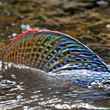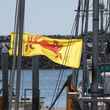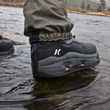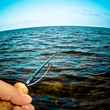Hardy’s Zenith rods, discontinued when the Wraith and Zephrus lines were introduced a few years ago, are among some of the most-loved sticks in recent memory.
Like the Zenith, Wraith, Zephrus and all Hardy rods from the last decade or so, the blanks for the new Zephrus Ultralite family are rolled in Korea. Perhaps surprisingly to some, where a blank is rolled or a rod is assembled doesn’t impact its performance or quality. In fact, the new Zephrus Ultralite from Hardy is likely my favorite fly rod currently on the market.
I’ve had the privilege of fishing the Zephrus Ultralite in a 9’9” 2wt, 8’9” 4wt, 9’ 5wt, 9’9” 4wt, and 9’9” 5wt over the past few months. And while each rod has its own personality, two things remained consistent throughout the new Ultralite family: unfair accuracy and strikingly smooth casting.
Starting at under $700 and offered in weights 2-5, the Zephrus Ultralite provides performance equal to or exceeding other rods priced much closer to the $1,000-mark.
What Works
Weight
As the name implies, the new Zephrus Ultralite is light. Notably light. And that’s saying something, given that the past half-decade or so has seen most rod makers touting the light weight of their blanks. But it’s become a moot point since rods like Winston’s IM6 or Sage’s XP hit the 3.5oz or lighter mark.
Yet Hardy is within its rights to brag about the weight of the Zephrus Ultralite because its ultra-light Ultratelite-ness is immediately evident from the second you pick it up.
Single-foot guides, a unique reel seat, and the company’s proprietary Sintrix 440 resin combine to create a 9’5wt rod that’s a paltry 2.5oz, while the 9’9” 5wt tips the scales at whopping 2.8oz.
Blank performance
So many aspects go into blank performance that it’s hard to single out one of them. Torsional stability affects tracking, which affects swing weight, which affects the action and “feel” of the rod itself.
To sum it all up as quickly as possible, I’ll mention just a few things. First, the Zephrus Ultralite's blank is surprisingly strong, stiff and stable given its weight. The tracking isn’t as tight as something like the Sage X or Orvis Helios 3, but it’s pretty damned close.
What’s impossible to notice until you actually fish the rod, though, is its backbone. It’s not really there when you’re casting—the Zephrus Ultralite has a decidedly medium action, very similar to the old Winston GVX—but the second you hook a fish you’ll feel it.
From high country Colorado River cutthroat trout to big browns and rainbows on the Green River in Utah, the blank’s backbone was more than strong enough to turn trout into the net. Hell, I landed a 20-inch whitefish on the 9’9” 2wt and even on that light tackle I got the fish to hand in a reasonable amount of time.
Accuracy and feel
Since the blank fares so well, the accuracy does too. From streamers to small dries to my standard dry-dropper rig, the Zephrus Ultralite put my flies where I needed them. Of course, accuracy is more dependent on the angler than the rod, but a great rod helps.
The first time I went to cast one of these rods, my local Hardy rep said he’d bet $20 I’d throw a tailing loop. Anyone who’s fished recent Hardy rods knows they’re on the faster end of the spectrum, and that’s what I expected when I threw my first lawn casts.
To my credit, I didn’t throw a tailing loop, but my first cast wasn’t exactly pretty. A few casts later I’d slowed my stroke down and found the rod loading and unloading line with a firm, predictable cadence.

Build quality and reel seat
The Zephrus Ultralite has a gorgeous dark green finish that glistens in the sunlight, along with some really intricate cross-wraps from the winding check up to the end of the rod inscriptions.
Titanium recoil single-foot guides adorn the rod, kept in place with thread that matches the blank color.
What’s really eye-catching, though, is the reel seat. The cork grip is soft, supple, and smooth—and that cork continues into the reel seat.
The front half of the reel seat —where the reel foot is held in place—is all cork. The back half has a thin bit of hardwood veneer, striking a unique balance between the classy look of wood and the light weight of cork.
What Doesn’t Work
Wind
Every high-end rod (which I classify as $650+) handles average wind just fine. They have to if they want to sell.
Where some rods separate themselves from others is in their ability to handle above-average wind. The Helios 3D and Sage X lead the pack in that regard. The Zephrus Ultralite just doesn’t live up to that level of wind-beating performance.
That’s the trade-off you make for light weight and insane feel in close and it’s one I’m personally happy to make. Some anglers may not be, though.
Line speed
Anglers used to high line speed, laser-tight loops, and the hiss of line shooting through your guides won’t get that experience from the Zephrus Ultralite. Its slower action means slower line speed, but that’s relative to the “norm” in today’s industry. Personally, I’m used to that sort of line speed, but most anglers aren’t.
Final Word
For $699.95 you can get the 9’ 5wt Zephrus Ultralite with Hardy’s lifetime warranty, superior build quality, and all the incredible performance attributes mentioned above. At that price there may not be a better rod on the market. I’d even go so far as to say the Zephrus Ultralite deserves to be in the conversation for best fly rod on the planet, alongside rods like the Sage X, Orvis Helios 3, Loomis Asquith and NRX-LP, Scott Radian, and Winston Boron IIIx.
The best part? The Zephrus Ultralite costs significantly less.





























Comments
Marc Barnwell replied on Permalink
How did the 9’9” 4 and 5 weights feel throwing dries?
Pages